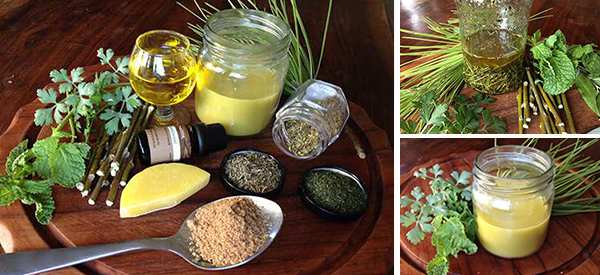
DIY Pain Relief Salve
To treat any form of pain, you should consider what symptoms you need to combat. In many cases, pain is associated with inflammation, fluid build-up, swelling, stiffness, muscle spasm, and/or a decrease in blood circulation. So, when making yourself a remedy for pain relief, you should take into account some of the causes of pain, and endeavor to treat them.
The next consideration when experiencing pain is to determine whether the area requires a hot or cold treatment. If the problem is stiffness and spasms, then usually a warming remedy should be applied, whereas inflammation and swelling are best treated with a cooling remedy. In either case, increasing circulation is also important for pain relief.
Magnesium is often taken to repair muscles after a strenuous day or after exercising because it reduces lactic acid build-up which allows fresh oxygen to the muscles.
I also consider what herbs and plants I can forage from my own garden and the surrounding area, or what I can purchase locally (and minimize my carbon footprint).
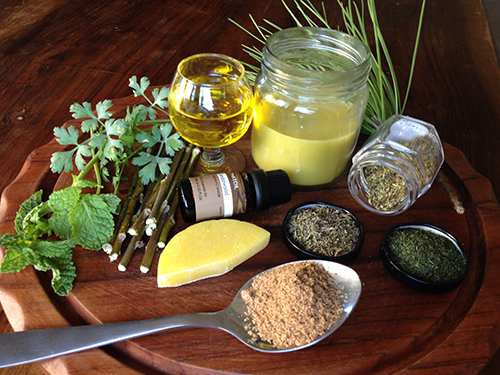
Cooling Herbs That Help To Relieve Pain
Below is a list of common herbs and plants that I have chosen to make a cooling salve to help relieve pain. Each plant does this differently, through various methods and medicinal compounds:
Peppermint minimizes pain by reducing spasms, muscle tension, and inflammation. It also has some magnesium for muscle repair. This is a great plant to grow in a pot, and regular trimming keeps it ready for harvest.
Parsley stimulates circulation by dilating blood vessels. It’s also high in antioxidants and contains some magnesium. Pruning parsley extends its harvest season (before it sets seed).
Thyme stimulates circulation and is an anti-inflammatory with the added bonus of some magnesium. Thyme responds well to regular trimming which also gives it a long harvest season.
Willow bark contains salicin which acts the same as aspirin, and it also has anti-inflammatory properties. Luckily, all willow tree species contain salicin, so you can easily strip the bark yourself from fresh, new growth, which is easier in Spring.
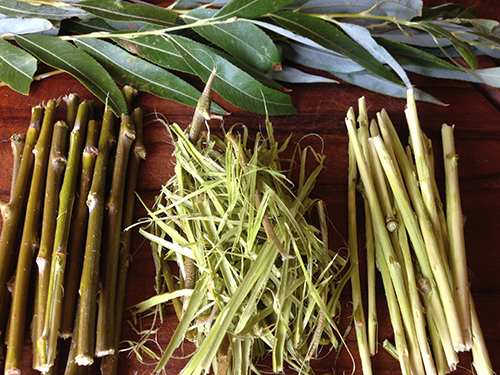
Pine bark and needles contain pycnogenol which is known to reduce inflammation by increasing circulation and red cell production. This increase in activity also aids in removing fluid build-up. They are also high in vitamin C, which is great for skin elasticity. Pine needles will take at least 3 days longer to dry compared to the other herbs listed here, but you can speed the process up a little by cutting up the needles before placing them in the sun. The needles are dry when they snap in half (instead of bending).
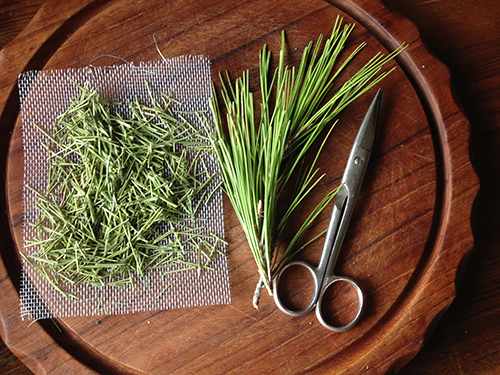
Sandalwood is an anti-inflammatory and also helps to relax the nervous system. I add a few drops of sandalwood essential oil at the end of the process.
Coriander leaves (also known as cilantro) have a cooling effect and increases circulation, plus the magnesium content helps with repairing sore muscles. It’s best to harvest the leaves before it flowers and sets seed.
Dill is anti-inflammatory and anti-spasmodic. It also stimulates circulation and contains magnesium. The harvesting season is reasonably long since you can harvest the leaves up until it has set seeds.
Oregano is an adaptogen and is relatively high in magnesium. It has an enormous array of medicinal properties, and with respect to treating pain, it relaxes muscles to prevent spasms.
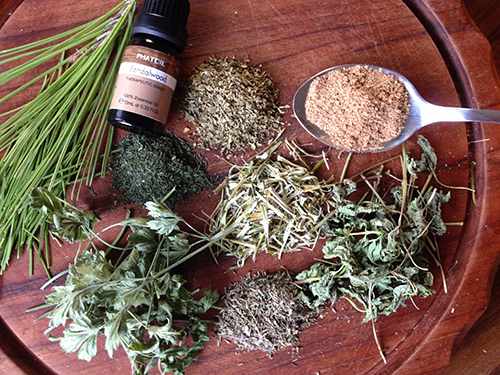
Below is a shortlist of other cooling herbs which can be substituted with the herbs above, since they have similar pain-relieving properties;
| HERB | PAIN RELIEF PROPERTIES |
|---|---|
| FEVERFEW | Reduces heat, natural pain killer |
| CHICKWEED | Anti-inflammatory, stimulates circulation, reduces fluid build-up |
| CHICORY ROOT | Pain-relieving properties like ibuprofen, repairs red blood cells and decreases inflammation |
| WILD LETTUCE | Anti-spasmodic, stimulates circulation |
| CRAMP BARK | Anti-spasmodic, reduces fluid build-up |
| TURMERIC | Anti-inflammatory, stimulates circulation but not appropriate for a salve (stains the skin) |
| COMFREY | Anti-inflammatory |
| EUCALYPTUS | Decreases inflammation and swelling |
| PRIMROSE | Anti-coagulant, stimulates circulation, anti-inflammatory |
| LAVENDER | Anti-inflammatory, relaxes muscles |
The best herbs to use are those you pick fresh and dry yourself, however at certain times of the year, it’s necessary to buy dried herbs instead. It is also possible to substitute dried herbs for essential oils, which are added at the end of the process.
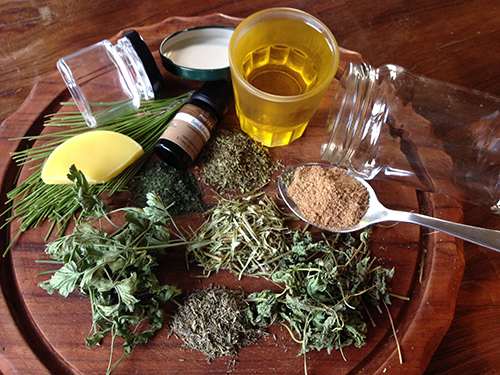
It is highly recommended to sterilize everything beforehand in boiling water. This will increase shelf life by decreasing the likelihood of growing mold.
To make your own pain relief salve at home simply follow these 2 steps;
Step 1: Make An Infused Herbal Oil
- Put about a tablespoon of each of the dried herbs listed above into a glass jar.
- Fill the jar up with olive oil so that all of the ingredients are covered. Screw on the lid and give it a shake.
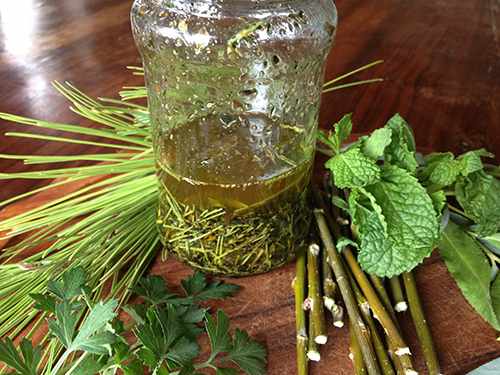
- Stand the jar in a pot of warm water (no more than 100°F) for at least 3 hours.
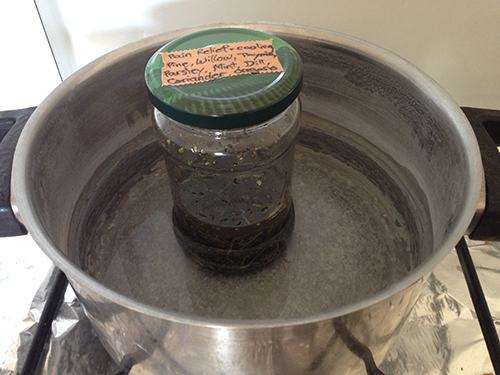
- You will need to reheat the pot of water and shake the jar occasionally. The oil will turn a darker color and will have taken on the aromas of the herbs when it’s ready.
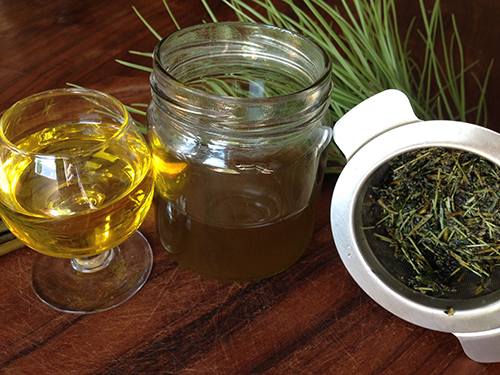
- Strain the herbal infused oil. Now you are ready for step 2.
Step 2: Make a Pain Relief Salve
I prefer to make my salve in the jar it will be stored in. This eliminates the need to pour the salve into other jars and minimizes the cleanup at the end.
- Place a teaspoon in the fridge (you will need this later).
- Pour about 50 – 60 ml of your herbal infused oil from step 1 into a small glass jar.
- Stand the jar in a pot of warm water.
- Add about 10 grams of beeswax and stir until it’s melted.
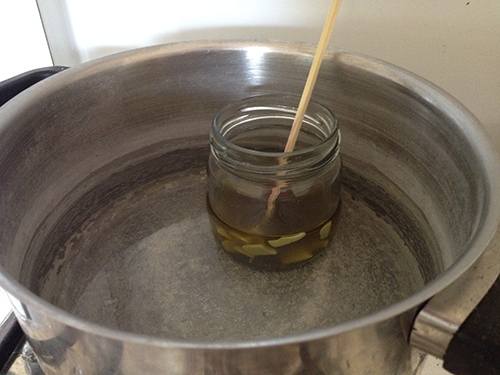
- Test the consistency with the cold teaspoon from the fridge. Add more infused oil if it’s too hard, or more beeswax if it’s too soft.
- Stir in a few drops of essential oil (in my case, sandalwood).
- Remove the jar from the pot of water and allow it to cool and solidify.
- Rub into your skin where you experience pain at least twice a day.
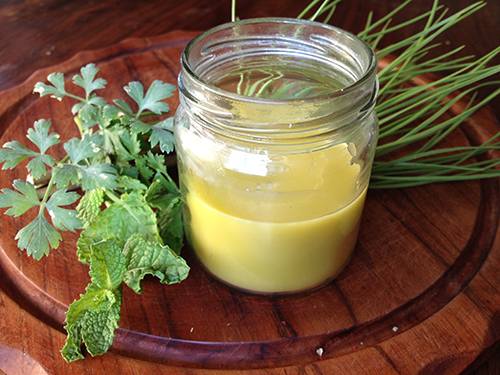
In many cases, when you start using herbal remedies the effect may not necessarily be immediate. It may take daily applications for a week or so before any obvious improvements are noticed.
You may also like:
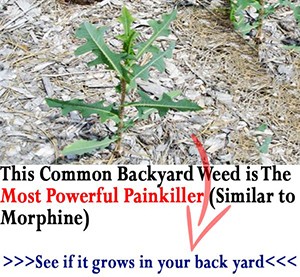 How to Reduce Pain Triggered by Weather Changes
How to Reduce Pain Triggered by Weather Changes
10 Medical Supplies You Need to Have in Your House (Video)
43 Remedies from My Childhood that Still Work Today

I love the recipes I have fibromyalgia, going to try the pain relief one. Thank you so very much.
Hi Teresa,
Thank you for your comment.
We are glad you liked the recipe.
God bless!
Can I ask why comfrey isn’t on this list?
It is, please review list
How to make infused oil with herbs